Printing processes play a crucial role in packaging, as they determine the visual appeal, quality, and overall impression of a product. With the ever-expanding packaging industry, choosing the right printing process has become increasingly important. In this article, we will explore the most commonly used printing processes in packaging and delve into their advantages, limitations, and applications.
Flexography, also known as flexo printing, is widely recognized as the primary printing process in the packaging industry. It involves the use of flexible relief plates and is highly suitable for printing on various substrates such as paper, cardboard, plastic, and even metallic films.
Advantages of Flexography:
Limitations of Flexography:
Flexography finds extensive application in packaging industries such as food and beverage, consumer goods, and pharmaceuticals.
Offset lithography, or simply offset printing, is a conventional printing technique widely employed in packaging due to its superior print quality and versatility. It involves transferring ink from a plate to a rubber blanket and then onto the packaging material.
Advantages of Offset Lithography:
Limitations of Offset Lithography:
Offset lithography is commonly used for packaging applications such as corrugated boxes, folding cartons, and labels.

Digital printing has revolutionized the packaging industry, providing exceptional flexibility and customization options. Unlike traditional printing processes, digital printing does not require printing plates but instead utilizes computer-controlled printing heads for direct ink application.
Advantages of Digital Printing:
Limitations of Digital Printing:
Digital printing is particularly prominent in the cosmetics, pharmaceutical, and e-commerce packaging industries.
Gravure printing, known for its excellent image reproduction and high-quality finishes, is often used for packaging materials that require intricate designs or metallic effects. It involves engraving the desired image onto a cylinder, which is later filled with ink and transferred onto the packaging material.
Advantages of Gravure Printing:
Limitations of Gravure Printing:
Gravure printing is extensively used in packaging sectors such as tobacco, personal care products, and high-end consumer goods.
Screen printing, renowned for its vibrant colors and tactile effects, offers a unique artistic dimension to packaging. It involves pressing ink through a mesh screen onto the packaging material, creating a variety of textures and finishes.
Advantages of Screen Printing:
Limitations of Screen Printing:
Screen printing is commonly utilized in packaging for beverages, cosmetics, and promotional items.
Letterpress printing, although less prevalent in modern packaging, still holds its place as a timeless and elegant printing process. It involves pressing inked plates onto the packaging material, creating a distinctive debossed effect.
Advantages of Letterpress Printing:
Limitations of Letterpress Printing:
Letterpress printing is commonly seen in high-end packaging applications, such as luxury goods, invitations, and specialty products.
Choosing the most appropriate printing process for packaging is crucial to ensure optimal visual impact, product differentiation, and brand representation. Flexography remains the most widely used printing process due to its versatility and efficiency. However, offset lithography, digital printing, gravure printing, screen printing, and letterpress printing each offer unique qualities that cater to specific packaging requirements. By considering the advantages, limitations, and applications of these printing processes, packaging designers and manufacturers can make informed decisions and create customized packaging solutions that captivate consumers and elevate their brands.
© Copyright: Shenzhen Asoka Printing Co.,Ltd All Rights Reserved. sitemap.xml | sitemap.html | Terms & Conditions | Privacy